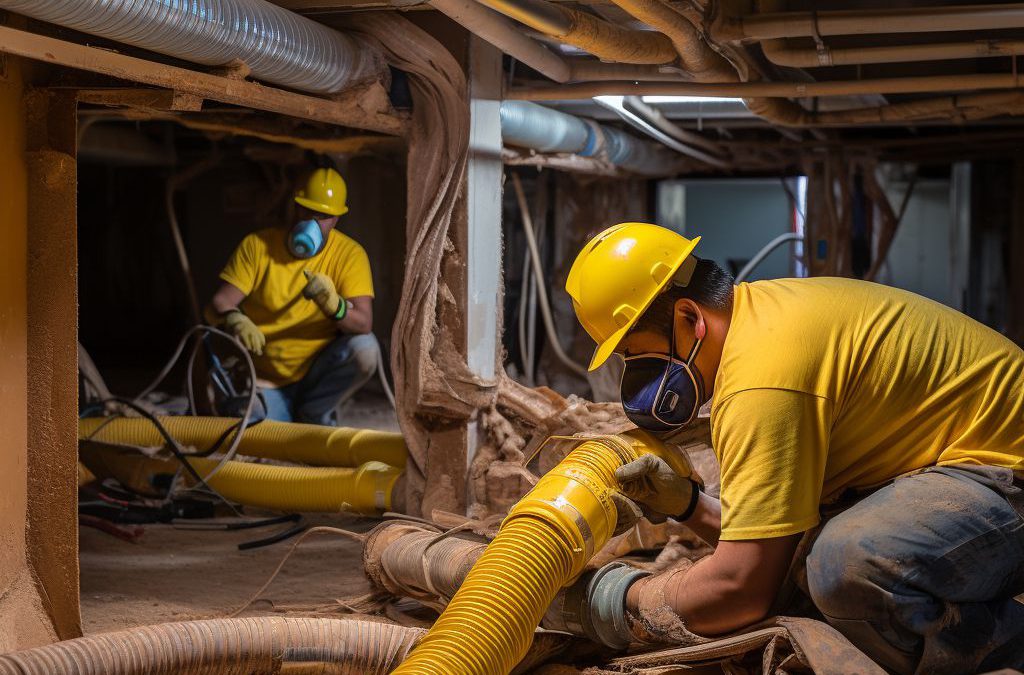As homeowners, we are often advised to maintain our homes regularly to ensure everything runs efficiently. Despite this, some essential elements may go overlooked, such as your HVAC ductwork. But did you know that after 20 years, your ductwork may not function as it should? This article explores the lifespan of ductwork and why it may be time to replace them to keep the air in your home healthy and safe.
Tabe of Contents
- 1. Understanding the lifespan of ductwork: Is 20 years the magic number?
- 2. Signs of wear and tear in older ductwork: What to look out for
- 3. The impact of outdated ductwork on indoor air quality and energy efficiency
- 4. Factors to consider when deciding whether to replace ductwork after 20 years
- 5. Upgrading ductwork: How to choose the right materials and professionals
- 6. Preventing premature ductwork replacement through regular maintenance and care
- People Also Ask
- Final Words
1. Understanding the lifespan of ductwork: Is 20 years the magic number?
Ductwork is an essential component in a home’s heating, ventilation, and air conditioning (HVAC) system. It is responsible for circulating air throughout the house and regulating indoor temperature, making it a crucial part of a comfortable and healthy living space. But just like any other home fixture, ductwork has a limited lifespan and needs to be replaced when it reaches the end of its useful life.
So, is 20 years the magic number for replacing ductwork? The answer is, it depends. While some ductwork can last 20 years or more, others may deteriorate sooner due to various factors such as installation quality, material quality, usage, and environmental conditions. According to the National Association of Home Builders, ductwork lifespan can range from 10 to 25 years, with the average lifespan being around 15 years.
It is important to note that the lifespan of ductwork also depends on the type of material used. For instance, galvanized steel ductwork is more durable than flexible ductwork made of plastic, which tends to wear out faster. Additionally, ductwork in areas with high humidity or extreme temperatures may experience more wear and tear and require replacement sooner.
In summary, 20 years is not necessarily the magic number for ductwork replacement. The lifespan of ductwork varies depending on several factors, including installation quality, material quality, usage, and environmental conditions. As a homeowner, it is crucial to be aware of the signs of wear and tear in older ductwork and to schedule regular maintenance to prolong their lifespan. Next, let’s look at the signs of wear and tear in older ductwork that homeowners should look out for.
2. Signs of wear and tear in older ductwork: What to look out for
Older ductwork can experience wear and tear, which can lead to a range of problems with air quality, energy efficiency, and even safety. Here are some signs to look out for when assessing your ductwork:
- Cracks and leaks: Visible damage to your ductwork is a sign that it may need to be replaced. Cracks and leaks can allow air to escape or enter the system, which can impact indoor air quality and energy efficiency.
- Duct sagging: If you notice that your ducts are sagging, it could indicate that they are not providing proper ventilation and may need to be replaced.
- Duct corrosion: Corrosion can lead to leaks and other damage to your ductwork. Signs of corrosion may include rust, flaking, or discoloration.
- Poor air quality: If you notice a decrease in your home’s indoor air quality, it could be due to an issue with your ductwork. Mold, bacteria, and other contaminants can grow in ductwork that is not properly maintained or replaced when necessary.
By being aware of these signs and regularly inspecting your ductwork, you can identify potential issues and address them before they cause significant problems. If you do notice any of these signs, it may be time to consider replacing your ductwork to ensure optimal air quality and efficiency in your home.
3. The impact of outdated ductwork on indoor air quality and energy efficiency
Is your home over 20 years old? If so, your ductwork may be reaching the end of its lifespan. Over time, ductwork can wear and tear, leading to leaks, blockages, and other issues. If left unaddressed, outdated ductwork can have a significant impact on your indoor air quality and energy efficiency.
In terms of indoor air quality, outdated ductwork can lead to poor ventilation and air circulation. Leaky ducts can result in dust, mold, and other pollutants circulating throughout your home. These pollutants can exacerbate allergies and respiratory issues and even lead to more serious health concerns.
In terms of energy efficiency, outdated ductwork can also have a significant impact on your utility bills. Leaky ducts can result in air escaping and not reaching its intended destination. This can lead to your HVAC system working harder than it needs to, resulting in higher energy usage and costs.
If you suspect that your ductwork may be outdated, it’s essential to have it inspected by a professional. A professional inspection can identify issues and help you determine whether your ductwork needs to be replaced.
Replacing outdated ductwork can have a significant impact on your home’s indoor air quality and energy efficiency. By upgrading to newer materials and addressing any issues, you can improve the air quality in your home and save money on your energy bills over time.
4. Factors to consider when deciding whether to replace ductwork after 20 years
When determining whether it’s time to replace your ductwork after 20 years, there are a variety of factors to consider. Here are some important things to keep in mind:
- Material of Ductwork: One factor to consider is the material of your ductwork. If it is made from galvanized steel, it may last longer than other materials like fiberglass or flex ducts. However, all ductwork materials will eventually wear down over time.
- Level of Wear and Tear: Another important factor is the level of wear and tear on your ductwork. If there are only minor leaks or tears, it may be possible to make repairs rather than replacing the entire system. However, if the ductwork is severely damaged or has extensive mold or dust buildup, replacement may be necessary.
- Budget: Budget is always a factor when considering any home improvement project, including replacing ductwork. While it may be a costly initial investment, replacing outdated ductwork can potentially save money in the long-term by improving energy efficiency and reducing energy bills.
- Indoor Air Quality: The quality of your indoor air is an important consideration when deciding whether to replace ductwork. Old, outdated ductwork can cause poor indoor air quality by circulating dust, mold, and other allergens throughout your home.
Ultimately, the decision to replace ductwork after 20 years depends on several factors unique to each individual home. If you’re unsure whether your ductwork needs to be replaced, consider consulting with a professional HVAC technician to evaluate the current condition of your ductwork and provide recommendations for repair or replacement options.
5. Upgrading ductwork: How to choose the right materials and professionals
Upgrading ductwork can improve air quality and energy efficiency in your home. However, it is crucial to choose the right materials and professionals to guarantee the best outcome. Here are some things to consider when upgrading your ductwork.
Choose the Right Materials
When upgrading your ductwork, it’s important to choose the right materials for your needs. Ducts can be made of different materials, including sheet metal, fiberglass, and plastic. The material you choose will impact the durability, energy efficiency, and maintenance needs of your ductwork.
Sheet metal ducts are the most durable and long-lasting option, while fiberglass and plastic ducts are less durable but more affordable. Consider your budget and needs before choosing a material.
Hire the Right Professionals
Ductwork replacement is a complex process that requires professional expertise. When hiring professionals, look for those who are licensed, insured, and experienced in ductwork replacement. It’s also essential to choose a reputable company that can guarantee quality workmanship.
Before hiring professionals, ask for references and read reviews from previous customers. This way, you can ensure you’re hiring trustworthy experts who can effectively upgrade your ductwork.
In conclusion, upgrading your ductwork can improve the air quality and energy efficiency in your home. However, it’s important to choose the right materials and professionals for the best results. Consider your needs and budget when choosing materials, and hire licensed, insured, and experienced professionals for quality workmanship.
6. Preventing premature ductwork replacement through regular maintenance and care
Regular maintenance and care of ductwork can significantly extend its lifespan and prevent premature replacement. Here are some simple tips to take care of your ductwork:
1. Change air filters regularly – Clogged air filters reduce the airflow and put a burden on the ductwork system. This can cause leaks and increase energy consumption. Changing the filters once every 1-3 months can help prevent this.
2. Keep vents clean – Dirt and debris can accumulate around vents, blocking the airflow and causing inefficient operation. Regularly cleaning the vents and removing any obstructions can prevent damage to the ductwork.
3. Seal ducts – Leaky ducts can lead to energy loss and increased utility bills. Seal any leaks with duct sealant or foil tape to reduce energy consumption and improve air quality.
4. Keep humidity levels under control – High humidity levels in the ductwork can cause mold growth and damage the system. Keeping humidity levels under control by using dehumidifiers or air conditioning systems can prevent premature ductwork replacement.
By following these simple maintenance tips, you can prevent premature ductwork replacement and extend its lifespan. If you suspect any significant damage or wear and tear in the ductwork, it’s essential to consult a professional HVAC technician for repair or replacement.
People Also Ask
How often should ductwork be replaced?
Typically, ductwork should be replaced every 15-25 years depending on its condition, usage, and maintenance routine. If you notice leaks, damage, or inefficient airflow, it might be time to replace your ductwork.
What are the signs of bad ductwork?
The signs of bad ductwork include inconsistent temperatures, weak airflow, excessive dust, mold growth, unpleasant smells, and high energy bills. These could indicate leaks, blockages, or wear and tear in the duct system.
Can old ductwork cause health problems?
Old ductwork that is contaminated with mold, bacteria, allergens, or other pollutants can cause or exacerbate health problems such as asthma, allergies, respiratory infections, or fatigue. Therefore, it is important to maintain and replace your ductwork regularly.
What is the cost of replacing ductwork?
The cost of replacing ductwork can vary widely depending on the type of ducts, the size of the system, the accessibility of the ducts, the location, and the labor costs. Typically, it could range from $1,000 to $7,000 or more.
Can I replace my own ductwork?
While it is possible to replace your own ductwork, it is not recommended unless you have the expertise, tools, and safety precautions necessary to do it properly. Improperly installed ductwork can be dangerous, inefficient, and costly in the long run.
Final Words
In summary, ductwork should be replaced after 20 years or earlier if it shows signs of wear and tear, leaks, blockages, or inefficient airflow. By replacing old or damaged ductwork, you can improve the comfort, air quality, and energy efficiency of your home or workplace, as well as reduce health risks and repair costs. Contact a professional HVAC technician to assess your duct system and recommend the best course of action.

Ductwork Specialist
Nathan’s meticulous duct cleaning services eliminate dust and debris, improving air quality and system efficiency. His attention to detail guarantees a thorough and effective cleaning process.

